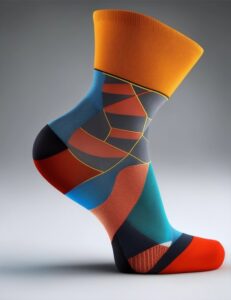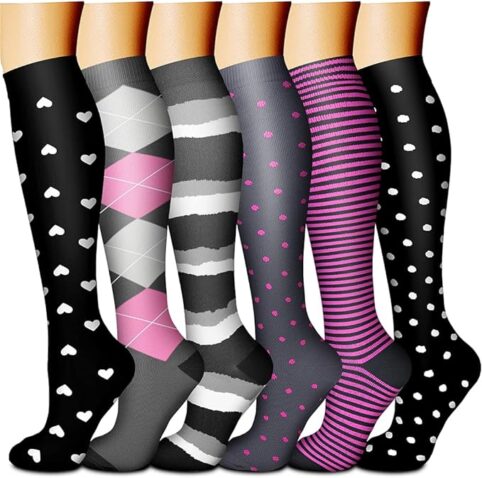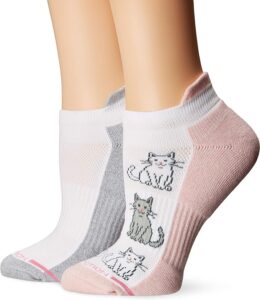Why buy womens compression socks? Because these socks are designed with women primarily in mind since men and women calves are not shaped the same way, although there are several unisex compression socks available in the market.
Receive guidance on how to select and buy womens compression socks to improve poor circulation in the legs and feet. The use of womens compression socks can be a helpful solution for those with circulation issues, but you can only derive the benefits by choosing the right pair.
This article provides an easy step-by-step guide to help you with this process. These guidelines apply to both women and men.
Step 1: Consult a Healthcare Professional
Before you go ahead and buy those womens compression socks, it is a smart move to have a chat with a healthcare expert like your doctor or a vascular specialist.
They can give you the lowdown on what you really need and suggest the right level of compression for your unique situation. This step is particularly important if you are dealing with a medical condition.
Keep in mind that picking compression socks for activities like running, walking, or jogging is a whole different ball game compared to choosing them for medical reasons where there is more at stake.
So, do not skip that important conversation with your healthcare professional. After buying your compression socks, it is also helpful to consult them again to ensure they fit correctly and provide the desired level of compression.
Step 2: Understand the Meaning of Compression Levels
Compression socks come in various compression levels, typically measured in millimeters of mercury (mmHg). The level of compression you need depends on the severity of your circulation issues:
- Mild compression (15-20 mmHg): Suitable for mild swelling and discomfort.
- Moderate compression (20-30 mmHg): Often recommended for moderate circulation problems.
- Firm compression (30-40 mmHg): For severe issues or as prescribed by a healthcare provider.
- Extra-firm compression (40-50 mmHg): Usually prescribed for serious conditions.
Step 3: Choose the Right Size
It is important that you purchase the right size of your womens compression socks. These socks come in various sizes, usually tied to your shoe size and the size of your calf.
To find the perfect fit, measure the widest part of your calf and then check out the sizing chart provided by the manufacturer.
The goal here is to get a sock that fits just right. That will ensure that you get the best compression and maximum comfort.
If you need help taking the measurements, find someone to assist with this. Measurements need to be as accurate as possible as this is a very important step in the process.
Step 4: Select the Style for Your Womens Compression Socks
There are several styles of compression socks available, each designed to cater to different needs and preferences. Let’s go through each style in detail:
Knee-High Compression Socks
Knee-high womens compression socks are one of the most common styles. They typically cover the foot and extend up to just below the knee.
Use: They are suitable for various purposes, such as improving circulation, reducing swelling, and preventing deep vein thrombosis (DVT). They are often recommended for those who sit or stand for extended periods, like office workers or travelers.
Thigh-High Compression Stockings
These compression stockings cover the entire leg up to the thigh. They may sometimes have a silicone band at the top to keep them in place.
Use: These stockings are often prescribed for individuals with more severe circulation issues, varicose veins, or those recovering from surgery. They provide compression to a larger area of the leg.
Compression Pantyhose or Tights
Similar to regular pantyhose or tights, compression pantyhose provide graduated compression throughout the legs, extending up to the waist.
Use: These are commonly used to address circulatory problems in the entire leg and are often prescribed for pregnant women to alleviate discomfort and swelling.
Open-Toe Compression Socks
These womens compression socks have an opening at the front, leaving the toes exposed. They look like regular knee-high or thigh-high socks but don not cover the toes.
Use: These are a great option if you want the benefits of compression but need to wear open-toed shoes or have sensitive toes. They allow for better ventilation and comfort in warm weather.
Compression Sleeves
Compression sleeves are designed to cover only the calf and lower leg without covering the foot.
Use: They are popular among athletes and runners as they provide compression to the calf muscles, reducing muscle fatigue and improving performance. They can also be worn under regular socks or with open-toed shoes.
Custom-Made Compression Garments
These tailor-made womens compression socks or garments are designed to fit your specific measurements and needs.
Use: Custom-made garments are often recommended for individuals with unique leg shapes or medical conditions requiring precise compression levels. They offer a personalized solution for maximum effectiveness.

Fashion Compression Socks
These womens compression socks are designed to look like regular socks but only provide mild compression. They come in various colors and patterns and are generally a hot favorite with women.
Use: These are for those who want the benefits of compression without sacrificing style. They can be worn as everyday socks while providing subtle compression support.
Remember that the choice of compression sock style should align with your specific needs. The level of compression, length, and style will vary based on your medical condition, lifestyle, and preferences.
Step 5: Select Materials for Comfort – Avoid Latex
Womens compression socks are available in different materials, such as nylon, spandex, cotton, or a blend of these. Choose a material that feels comfortable against your skin.
Moisture-wicking and breathable materials are often preferred for all-day wear. Always check for the type of material before grabbing your pair of socks.
Latex compression socks, also known as rubber compression socks are less common and less preferred compared to other materials like nylon, spandex, or cotton for several reasons:
- Latex can cause skin irritation, itching, redness, and, in severe cases, allergic reactions.
- It is not as breathable as other materials like nylon and spandex, making them less comfortable to wear for extended periods, especially in hot and humid conditions, as they may trap moisture and heat against the skin.
- It may not manage moisture and odor as effectively as other materials. This can lead to discomfort and potential skin issues over time.
- Latex womens compression socks typically come in a limited range of styles and colors.
- While latex is known for its durability, it may not be as flexible or comfortable as other materials over time.
- Fortunately, latex compression socks may be less readily available in comparison to more popular materials as many manufacturers primarily use nylon, spandex, or other synthetic blends due to the potential issues associated with latex.
Because of these reasons, many people with circulation issues or those who require compression socks for medical reasons often prefer latex-free alternatives made from materials like nylon and spandex.
These materials are known for their comfort, breathability, moisture-wicking properties, and a wide range of style options.
However, if you do not have latex allergies or sensitivities and find latex compression socks comfortable, they may still be a suitable choice for you.
Step 6: Check for Open-Toe or Closed-Toe
Some womens compression socks have open-toe designs, which can be more comfortable for those who prefer their toes to be uncovered. Closed-toe socks offer more consistent compression throughout the foot.
Step 7: Compression Sock Brands
Research reputable brands that specialize in medical and non-medical-grade compression socks. Popular brands include
Champion Womens Compression Socks, Graduated Socks – Crew and Mid-crew, 3-pack
Medipeds Women’s Diabetic Over The Calf Socks with Compression Fit 2 Pairs
Dr. Motion Womens 2pk Compression Low Cut Socks
Truform Sheer Compression Stockings, 15-20 mmHg, Women’s Knee High Length
Buy compression socks from specialized medical supply stores, pharmacies, or reputable online retailers. These sources are more likely to carry a wide range of compression sock options than your mega supermarket chains or local 7-11.
Step 8: Read Reviews
Look for customer reviews and testimonials to get an idea of the quality and effectiveness of the compression socks you wish to buy. The higher the customer ratings and quality of reviews, the more confident you can be bout your proposed purchase.
Step 9: Follow Care Instructions
Proper care of compression socks is essential to maintain their effectiveness and extend their lifespan.
Here are some general care instructions for compression socks, but ensure that you also refer to the manufacturers’ guidelines for any special care instructions.
Hand Wash or Gentle Machine Wash your compression socks using a mild detergent in cold or lukewarm water. If you use a washing machine, place the socks in a mesh laundry bag to protect them from damage.
When hand washing, gently agitate the socks by squeezing and rubbing them, but avoid twisting or wringing them out.
Rinse the socks thoroughly to remove all detergent residue, which can irritate the skin.
Gently squeeze out excess water from the socks without twisting or wringing. Lay them flat on a clean towel and roll the towel to absorb more moisture. Avoid hanging them by the tops, as this can stretch out the elastic.
Instead, lay them flat to air dry.
Avoid Using Hot Water or Exposure to Heat as it can damage the elastic fibers in the socks, affecting their compression properties.
Do not expose compression socks to direct heat sources like radiators or dryers, as high heat can damage the elastic fibers. Store your compression socks in a clean, dry place.
Avoid Using Bleach and Fabric Softeners when washing compression socks, as these can degrade the fabric and elastic.
Rotate Pairs: If you wear compression socks daily, it is a good idea to have multiple pairs and rotate them. This reduces wear and tear on a single pair and extends their lifespan.
Inspect Regularly for Thinning or Snags for signs of wear, such as thinning, stretching, or snags. Replace them when they show signs of wear to ensure proper compression.
Keep your toenails trimmed to prevent accidental damage to the fabric while putting on or taking off the socks.
Conclusion – How to Select and Buy Womens Compression Socks
While this articles discusses how to select and buy women’s compression socks to improve poor circulation in the legs and feet, remember that compression socks are only a part of a comprehensive approach to managing circulation issues.
Follow your healthcare provider’s advice and maintain a healthy lifestyle, including regular exercise and a balanced diet, to improve overall circulation in your legs and feet.
Related Articles
- The Causes of Poor Blood Circulation in Aging Adults
- Compression Leg Socks – How to Select and Buy
- Poor Circulation Problems in Seniors – The Real Dangers
- The Best Products that Can Help Improve Poor Blood Circulation
- Compression Socks for Men or Women – Better Than Unisex?
FAQ
What compression level do I need?
Choose based on your needs: 15-20 mmHg for mild support, 20-30 mmHg for moderate compression, and 30-40 mmHg for medical-grade support. Consult with a healthcare professional for specific recommendations based on your condition.
How do I find the right size?
Measure your calf and ankle circumference accurately, then refer to the sizing chart provided by the manufacturer. Proper fit ensures effectiveness and comfort.
Are there any special features to look for in womens compression socks?
Opt for breathable, moisture-wicking fabrics, seamless construction to prevent irritation, and reinforced heel and toe for durability. Consider stylish designs if you want to merge fashion with functionality.
References
Howley, E.K (2023) The Most Common Signs of Poor Circulation and How to Improve Them https://health.usnews.com/wellness/articles/how-to-improve-poor-circulation



